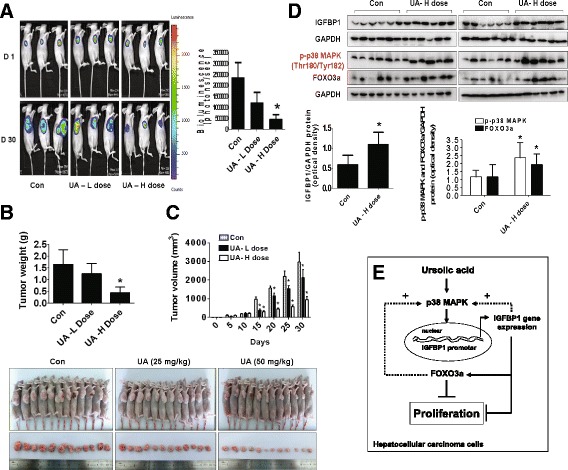Fig. 7.

In vivo anti-tumor efficacy of UA in subcutaneous HCC tumor-bearing nude mice. Mice (n = 12/group) were divided to 3 groups [Con (saline), Low (L, 25 mg/kg) and High doses of UA (H, 50 mg/kg)], and UA was given daily around the 10th day after tumor cells injection by gavages for up to 30 days. a, The xenografts were assessed by in vivobioluminescence imaging at the first and the end of the experiments [on day 1 (D 1) and Day 30 (D 30)]. The tumor growth was monitored by injecting luciferin in the mice followed by measuring bioluminescence using IVIS Imaging System. Imaging and quantification of signals were controlled by the acquisition and analysis software living image as described in the Materials and Methods section. Representative images are shown. b and c, The xenografts were harvested on day 30, and the volume and weight of tumors were measured. d, At the end of the experiments, xenografted tumors in each group were isolated and the tumors lysates were processed for detecting IGFBP1, FOXO3a protein and phosphorylation of p38 MAPK by Western blot. GAPDH was used as loading control. The bar graphs represented the tumor weight and volume of mice results as mean ± SD. *Indicates the significant difference from untreated control (p < 0.05). e, The diagram shows that UA inhibits growth of HCC cells through p38 MAPK-mediated induced expressions of IGFBP1 and FOXO3a. The interactions and correlations between IGFBP1 and FOXO3a, and the feedback regulatory loop of p38 MAPK by IGFBP1 and FOXO3a resulting in reciprocal pathways, contribute to the overall effects of UA
